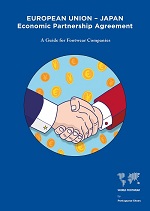Register to continue reading for free
EU-Japan EPA: a practical guide for footwear companies

The Economic Partnership Agreement (EPA) between the European Union and Japan entered into force last year creating the largest open trade zone in the world. Today we bring you a practical guide for footwear companies
As we celebrate the first anniversary of the entry into force of the Economic Partnership Agreement between the European Union (EU) and Japan, we have prepared a PRACTICAL GUIDE FOR ALL FOOTWEAR COMPANIES based in Japan and in the EU and aiming to trade under the current framework.
The document can be DOWNLOADED free of charge and it includes two main chapters, one with an overview of the European Union - Japan Economic Partnership Agreement and a second section dedicated to Footwear. Within this chapter you will find a practical Flowchart explaining How to Determine the Rule of Origin for FOOTWEAR in order to benefit from the preferential tariff rates applicable to products originating in either Japan or the EU.
The EPA will remove a vast majority of the duties paid annually giving the companies from these countries a competitive advantage in the EU and Japanese markets compared to operators from countries who have no agreement in place. According to estimates by the European Union, the annual trade between the EU and Japan could increase by nearly 36 billion euros once the agreement is implemented in full.
Footwear
Under the agreement, tariffs applied to European Union originating footwear entering Japan will be phased out over the next years. Tariffs on key leather products such as handbags will be eliminated over a decade, and the traditionally protected products with very high tariffs (27%), such as sports shoes and ski boots, will also be liberalised over the same period. On the other hand, with the entry into force of the agreement the immediate end of the quota system was applied for EU footwear exports which should bring significant gains for exporters of leather hides and skins.
On the other side, Japan will benefit from the immediate removal of tariffs on several products, such as the categories of leather footwear. For many others, EU custom duties on footwear will initiate with tariffs around 17% and will be eliminated over 10 years, in most instances, and with a small group of tariff lines facing a 15 years transition period until complete elimination is reached.
On the other side, Japan will benefit from the immediate removal of tariffs on several products, such as the categories of leather footwear. For many others, EU custom duties on footwear will initiate with tariffs around 17% and will be eliminated over 10 years, in most instances, and with a small group of tariff lines facing a 15 years transition period until complete elimination is reached.









